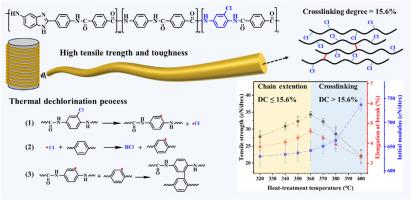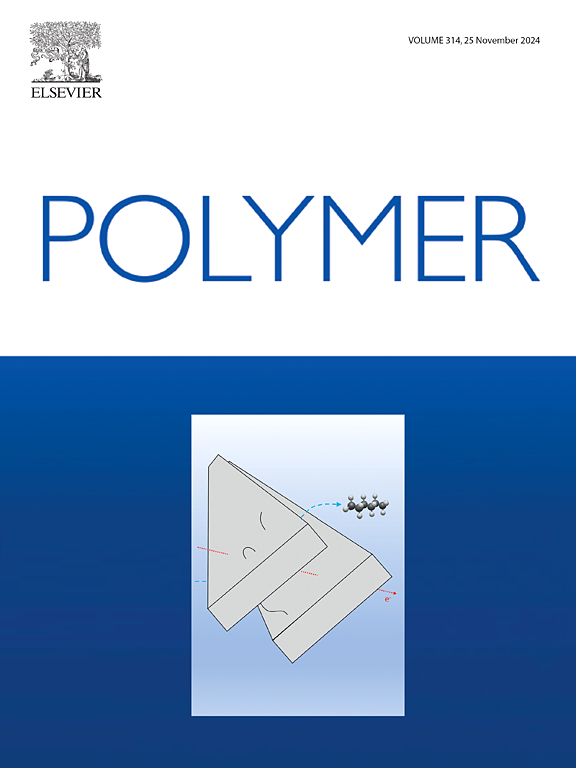Thermal dechlorination induces chain extension to simultaneously improve the tensile strength and toughness of heterocyclic aramid
IF 4.1
2区 化学
Q2 POLYMER SCIENCE
引用次数: 0
Abstract
The heterocyclic aramid (PBIA) has important applications in bulletproof protection and composites reinforcement. However, there are intrinsic conflicts to simultaneously improve the tensile strength and toughness. Herein, the chlorine groups are introduced into PBIA chains by copolymerization to prepare containing chlorine heterocyclic aramid (ClPBIA). The single crystal data and WAXD patterns revealed the effect of introducing chlorine groups on the fiber structures. 1H-NMR and high-resolution mass spectra (HRMS) show that intermolecular radical-coupling reactions occur during thermal dechlorination of chlorine groups (≥340 °C). The crosslinking degree (DC) of ClPBIA fibers increases with increasing the heat-treatment temperature, which generates chain extension effects and crosslinking effects in sequence. In chain extension effects (DC≤15.6%), the molecular weight of ClPBIA fibers increases, and the tensile strength (27.75∼34.29 cN/dtex) and elongation at break (3.82%∼4.61%) increase simultaneously. In crosslinking effects (DC>15.6%), the polymer crosslinked network gradually forms. Then, the initial modulus begins to increase significantly from 642 cN/dtex to 737 cN/dtex, but the tensile strength and elongation at break decrease. The molecular dynamics simulation also demonstrated the dependence of chain extension effects and crosslinking effects on the DC, and the mobility of polymer chains decreases a lot from chain extension effects to crosslinking effects. Therefore, the tensile strength and toughness of ClPBIA fibers are simultaneously improved by controlling the DC in the chain extension effects. Compared with PBIA, the highest tensile strength (34.29 cN/dtex) and toughness (103.7 MJ/m3) of ClPBIA increase by 8.3% and 18.9%, respectively.

求助全文
约1分钟内获得全文
求助全文
来源期刊

Polymer
化学-高分子科学
CiteScore
7.90
自引率
8.70%
发文量
959
审稿时长
32 days
期刊介绍:
Polymer is an interdisciplinary journal dedicated to publishing innovative and significant advances in Polymer Physics, Chemistry and Technology. We welcome submissions on polymer hybrids, nanocomposites, characterisation and self-assembly. Polymer also publishes work on the technological application of polymers in energy and optoelectronics.
The main scope is covered but not limited to the following core areas:
Polymer Materials
Nanocomposites and hybrid nanomaterials
Polymer blends, films, fibres, networks and porous materials
Physical Characterization
Characterisation, modelling and simulation* of molecular and materials properties in bulk, solution, and thin films
Polymer Engineering
Advanced multiscale processing methods
Polymer Synthesis, Modification and Self-assembly
Including designer polymer architectures, mechanisms and kinetics, and supramolecular polymerization
Technological Applications
Polymers for energy generation and storage
Polymer membranes for separation technology
Polymers for opto- and microelectronics.
 求助内容:
求助内容: 应助结果提醒方式:
应助结果提醒方式:


